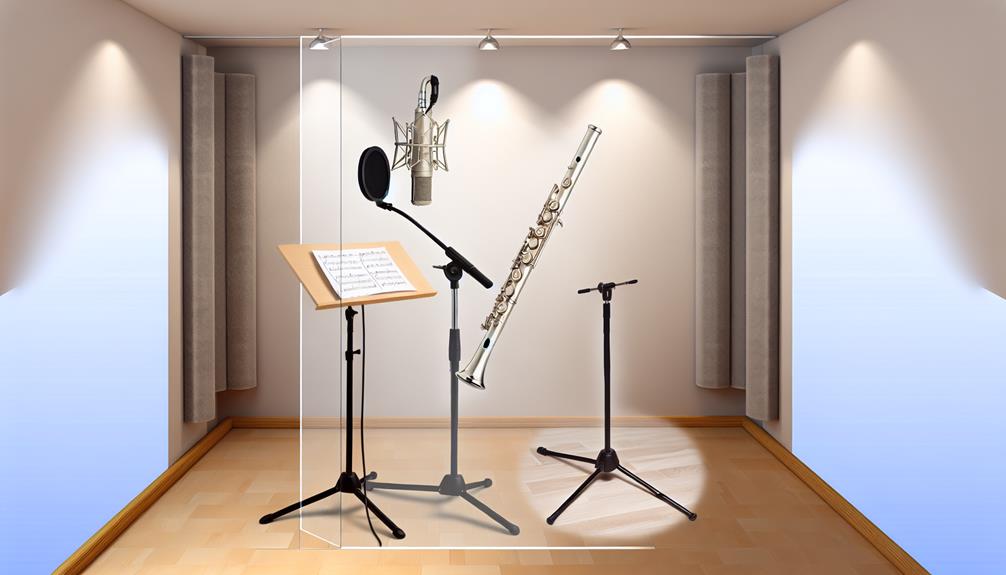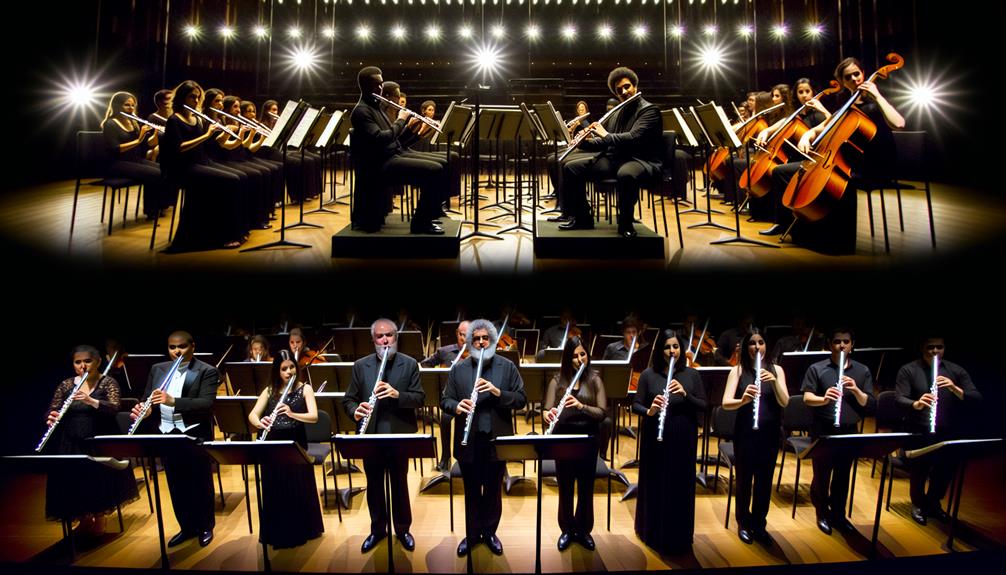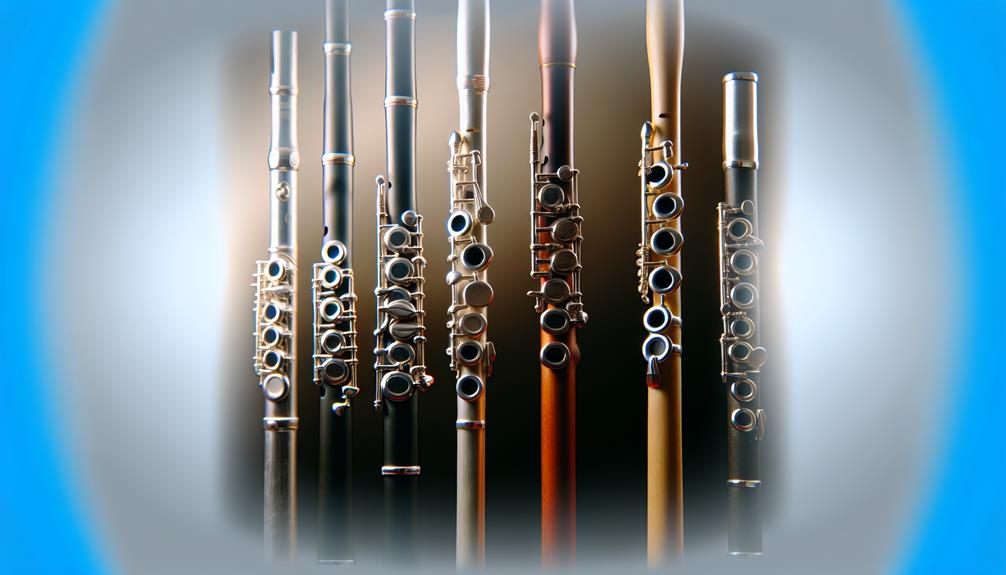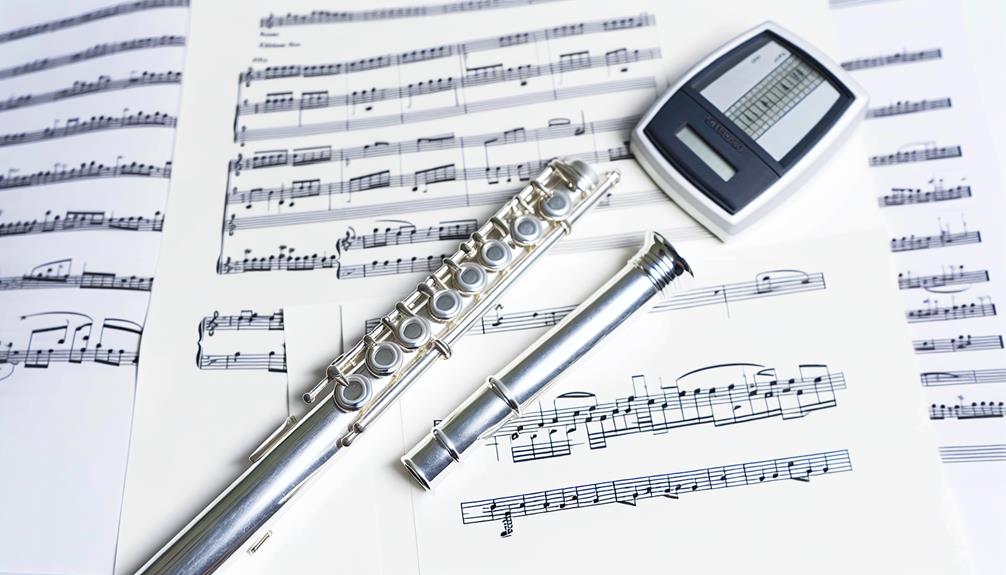When exploring the world of flutes, one may encounter a variety of instruments each with its unique characteristics and sound. Among these, there are five flutes that hold distinct positions in the realm of music.
The Western Concert Flute, Piccolo, Alto Flute, Bass Flute, and Contrabass Flute each contribute their own sonorous qualities to musical compositions. Understanding the differences between these flutes not only enriches one's knowledge but also opens a gateway to a diverse range of musical possibilities.
Each flute's distinct features and capabilities offer a fascinating journey into the world of woodwind instruments.
Key Takeaways
- Western concert flute, piccolo, alto flute, bass flute, and contrabass flute are the 5 main types.
- Each flute has unique characteristics in terms of pitch, sound, and playing techniques.
- They cater to diverse musical needs, from high-pitched piccolo to deep tones of contrabass flute.
- These flutes contribute distinct colors and textures to orchestras, ensembles, and solo performances.
Western Concert Flute
The Western Concert Flute, known for its elegant design and versatile sound, is a prominent member of the woodwind family in orchestral settings. Its rich history dates back to the 19th century, where it gained popularity for its clear and bright tones that can effortlessly cut through the symphonic texture. Crafted from silver, nickel, or gold, the flute's sleek appearance often captivates both musicians and audiences alike.
This instrument holds a special place in classical music, offering a wide range of expressive possibilities. From delicate, ethereal melodies to lively, agile passages, the Western Concert Flute seamlessly navigates various musical genres with grace and finesse. Its presence in orchestras, chamber ensembles, and solo performances underscores its adaptability and allure.
Aspiring flutists often find a sense of belonging when embracing the Western Concert Flute. Its inclusion in prestigious orchestras and ensembles worldwide serves as a testament to its significance in the realm of classical music. Whether played as a solo instrument or as part of a larger ensemble, the flute's distinctive timbre resonates with both performers and listeners, fostering a deep connection within the musical community.
Piccolo
A diminutive member of the flute family, the piccolo is renowned for its distinctive high-pitched tones. Often referred to as the highest-pitched instrument in the orchestra, the piccolo adds a bright and piercing quality to musical compositions. Its small size belies the powerful sound it produces, making it a crucial component in marching bands, orchestras, and concert bands.
Despite its compact nature, the piccolo requires a high level of skill to play effectively due to its challenging fingering and the need for precise embouchure control. Musicians who master the piccolo are valued for their ability to cut through the ensemble with its clear and penetrating sound.
Used not only for its ability to play melody lines but also to provide color and texture to musical arrangements, the piccolo is a versatile instrument that plays a significant role in various musical genres. Its unique timbre and ability to soar above other instruments make it an indispensable part of the flute family.
Alto Flute
Known for its rich and mellow tones, the alto flute is a versatile member of the flute family that offers a unique timbre in musical performances. Larger and lower in pitch than the traditional concert flute, the alto flute produces a warm and velvety sound that adds depth and richness to ensembles. Its captivating timbre makes it a popular choice for solo pieces, chamber music, and orchestral compositions, where its distinct voice can be heard above other instruments.
The alto flute is often used to convey emotive melodies or to provide a contrasting texture within a musical piece. Its extended range allows for expressive playing across different genres, from classical to contemporary music. Due to its larger size, the alto flute requires slightly different fingering techniques compared to the standard flute, but with practice, musicians can master its unique characteristics and unlock the full potential of this captivating instrument.
Bass Flute
With a deeper and more resonant sound than the alto flute, the bass flute is an intriguing member of the flute family that offers a distinctive timbre in musical compositions.
The bass flute is larger in size, with a curved head joint and a U-shaped tube that extends to approximately 57 inches. Its lower pitch range enriches the harmonies in ensembles and provides a foundation for the flute section.
Due to its size and weight, playing the bass flute requires some physical strength and good breath control to produce a full, rich tone.
The bass flute is commonly used in orchestral settings, chamber music, and contemporary pieces to add depth and color to the overall sound. While not as prevalent as the standard C flute, the bass flute plays a crucial role in expanding the tonal possibilities within the flute family, captivating both performers and listeners alike with its unique characteristics.
Contrabass Flute
The Contrabass Flute, boasting a significantly lower range than the bass flute, is a distinctive and rare member of the flute family, known for its rich and resonant tones. This impressive instrument adds depth and gravitas to any musical ensemble, making it a sought-after choice for composers looking to expand their sonic palette.
Key Features of the Contrabass Flute:
- Unique Sound: The Contrabass Flute produces deep, mellow tones that resonate with a haunting quality, standing out from other instruments in its range.
- Impressive Size: With its elongated tube and large key mechanism, the Contrabass Flute is a visually striking instrument that commands attention on stage.
- Challenging Technique: Playing the Contrabass Flute requires significant breath control and embouchure precision due to its size and the lower register it operates in.
Frequently Asked Questions
Can Flutes Be Made Out of Materials Other Than Metal, Such as Wood or Plastic?
Flutes can indeed be crafted from materials other than metal, including wood and plastic. These alternative materials offer unique tonal qualities and aesthetics, broadening the range of options for musicians seeking a specific sound or visual appeal.
Are There Any Unique Techniques or Playing Styles Specific to Each Type of Flute?
Each type of flute, such as the piccolo or alto flute, offers unique playing styles and techniques. Understanding these distinctions can enrich a flutist's repertoire, allowing for a diverse and expressive musical experience.
What Are Some Famous Classical Music Pieces That Prominently Feature Each Type of Flute?
Some famous classical music pieces that prominently feature each type of flute are "Syrinx" by Debussy for solo flute, "Concerto for Flute, Harp, and Orchestra" by Mozart for classical flute, "Suite Antique" by Rutter for alto flute, "Concerto for Flute and Harp" by Mozart for piccolo, and "Concerto for Flute and Orchestra" by Nielsen for bass flute.
Are There Any Specific Accessories or Equipment Needed to Play Each Type of Flute?
To play each type of flute effectively, specific accessories are necessary. These may include cleaning rods, cloths for maintenance, cases for protection, tuning forks for pitch accuracy, and metronomes for rhythm practice. Each accessory enhances the player's performance.
Are There Any Lesser-Known Types of Flutes Beyond the Western Concert Flute, Piccolo, Alto Flute, Bass Flute, and Contrabass Flute?
In the realm of flutes, lesser-known varieties beyond the common Western concert, piccolo, alto, bass, and contrabass flutes do exist. Examples include the dizi from China, bansuri from India, and shakuhachi from Japan, each offering unique sounds and cultural significance.
Conclusion
In conclusion, the five flutes are known as the Western Concert Flute, Piccolo, Alto Flute, Bass Flute, and Contrabass Flute. These instruments offer a range of tones and pitches, allowing for diverse musical expressions.
One might say that these flutes are the quintessential embodiment of harmony and melody, creating a symphony of sound that captivates audiences worldwide.
Truly, the flutes are a testament to the beauty and complexity of the musical world.






